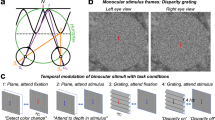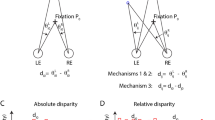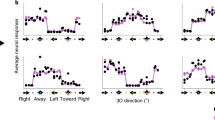Abstract
WE experience the visual world as being three-dimensional. A major source of depth information derives from the slightly different views of each eye, leading to small variations in the retinal images ('disparities')' Neurons sensitive to visual disparities are thought to form the neural basis of stereo vision1–10. Barn owls2,3 as well as several mammalian species1,4–10 have neurons that are sensitive to visual disparities. But how visual disparities are represented in the brain has been a matter of discussion ever since the first disparity-sensitive neurons were found some 25 years ago. Here we adopt a new approach to this problem and study the neural computation of visual disparities with a paradigm borrowed from auditory research. The measurement of interaural time difference (ITD) has many similarities with the measurement of visual disparity on the formal, algorithmic level. We speculate that the similarities might extend to the level of neural computation. The neural representation of ITD is well understood11–18, and we have studied the representation of disparities with visual stimuli analogous to those successfully used in acoustic experiments. For example, ITD is converted in the brain to a pathlength on an axon that, owing to the finite conduction velocity in neurons, exactly matches the external ITD. This pathlength is called 'characteristic delay'12. Our results suggest that there is an analogue of the characteristic delay in stereo vision which we propose to call 'characteristic disparity'.
This is a preview of subscription content, access via your institution
Access options
Subscribe to this journal
Receive 51 print issues and online access
$199.00 per year
only $3.90 per issue
Buy this article
- Purchase on Springer Link
- Instant access to full article PDF
Prices may be subject to local taxes which are calculated during checkout
Similar content being viewed by others
References
Barlow, H. B., Blakemore, C. & Pettigrew, J. D. J. Physiol. 193, 327–342 (1967).
Pettigrew, J. D. & Konishi, M. Science 193, 675–678 (1976).
Pettigrew, J. D. Proc. R. Soc. Lond. B204, 435–454 (1979).
Maske, R., Yamane, S. & Bishop, P. O. Vision Res. 24, 1921–1929 (1984).
Poggio, G. F., Motter, B. C., Squatrito, S. & Trotter, Y. Vision Res. 25, 397–406 (1985).
Ohzawa, I. & Freeman, R. D. J. Neurophysiol. 56, 221–242 (1986).
Ohzawa, I. & Freeman, R. D. J. Neurophysiol. 56, 243–259 (1986).
Ohzawa, I., deAngelis, G. C. & Freeman, R. D. Science 249, 1037–1041 (1990).
DeAngelis, G. C., Ohzawa, I. & Freeman, R. D. Nature 352, 156–159 (1991).
Hammond, P. Expl Brain Res. 87, 615–623 (1991).
Jeffress, L. A. J. comp. Phys. Psychol. 41, 35–39 (1948).
Rose, J. E., Grass, N. G., Geisler, C. D. & Hind, J. E. J. Neurophysiol. 29, 288–314 (1966).
Yin, T. C. T. & Kuwada, S. in Dynamic Aspects of Neocortical Function (eds Edelman, G. M., Gall, W. E. & Cowan, W. M.) 263–313 (Wiley, New York, 1984).
Takahashi, T. & Konishi, M. J. Neurosci. 6, 3413–3422 (1986).
Sullivan, W. E. & Konishi, M. Proc. natn. Acad. Sci. U.S.A. 83, 8400–8404 (1986).
Wagner, H., Takahashi, T. & Konishi, M. J. Neurosci. 7, 3105–3116 (1987).
Konishi, M., Takahashi, T. T., Wagner, H., Sullivan, W. E. & Carr, C. E. in Auditory Function (eds Edelman, G. M., Gall, W. E. & Cowan W. M.) 721–745 (Wiley, New York, 1988).
Carr C. E. & Konishi M. J. Neurosci. 10, 3227–3246 (1990).
Julesz, B. Foundations of Cyclopean Perception (University of Chicago Press, Illinois, 1971).
Blake, R. & Wilson, H. R. Trends Neurosci. 14, 445–452 (1991).
Moiseff, A. J. comp. Physiol. A 164, 637 (1989).
Karten, H. J., Hodos, W., Nauta, W. J. H. & Revzin, A. M. J. comp. Neurol. 150, 253–278 (1973).
Steinbach, M. J. & Money, K. E. Vision Res. 13, 889–891 (1973).
Movshon, J. A., Thompson, I. D. & Tolhurst, D. J. J. Physiol. 283, 101–120 (1978).
Nomura, M., Matsumoto, G. & Fujiwara, S. Biol. Cybern. 63, 237–242 (1990).
Pettigrew, J. D. in Vision: Coding and Efficiency (ed. Blakemore, C.) 283–290 (Cambridge University Press, UK, 1990).
Hubel, D. H. & Wiesel, T. N. J. Physiol. 160, 106–154 (1962).
Author information
Authors and Affiliations
Rights and permissions
About this article
Cite this article
Wagner, H., Frost, B. Disparity-sensitive cells in the owl have a characteristic disparity. Nature 364, 796–798 (1993). https://doi.org/10.1038/364796a0
Received:
Accepted:
Issue Date:
DOI: https://doi.org/10.1038/364796a0
This article is cited by
-
Visual categories and concepts in the avian brain
Animal Cognition (2023)
-
Evaluation of two minimally invasive techniques for electroencephalogram recording in wild or freely behaving animals
Journal of Comparative Physiology A (2013)
-
From optics to attention: visual perception in barn owls
Journal of Comparative Physiology A (2011)
-
The evolution of stereopsis and the Wulst in caprimulgiform birds: a comparative analysis
Journal of Comparative Physiology A (2006)
-
Two ears and two eyes
Nature (1993)
Comments
By submitting a comment you agree to abide by our Terms and Community Guidelines. If you find something abusive or that does not comply with our terms or guidelines please flag it as inappropriate.



